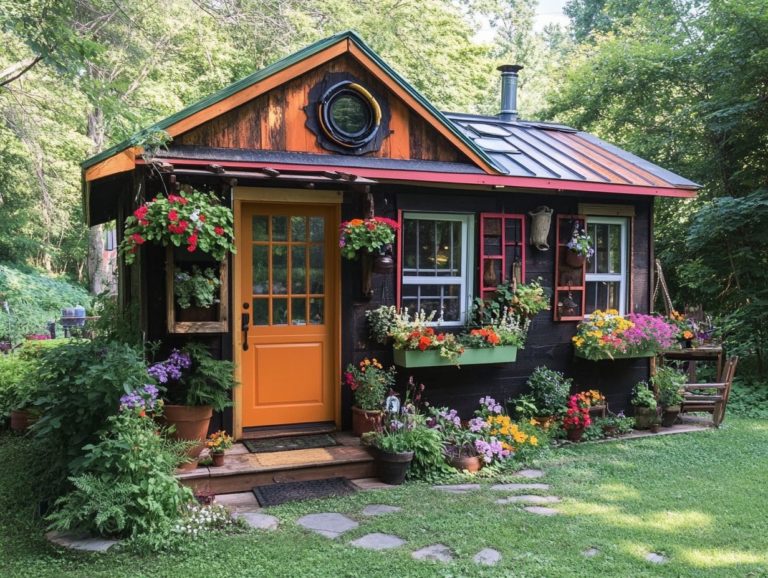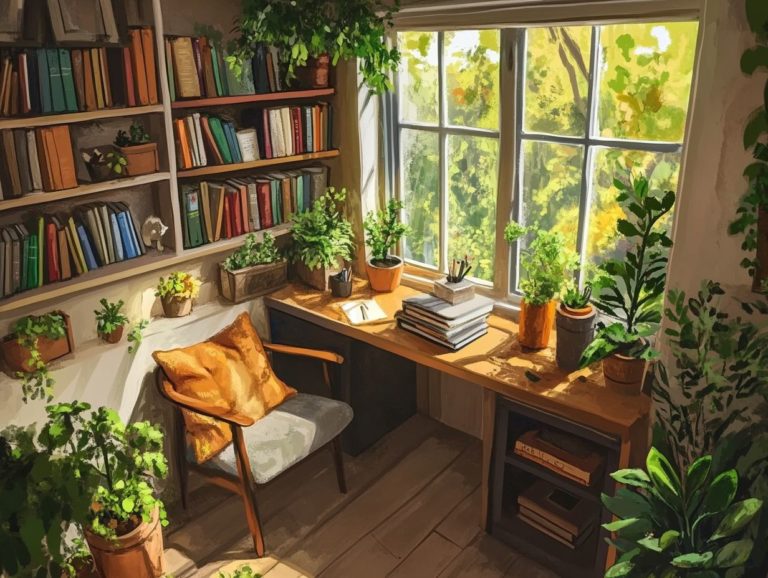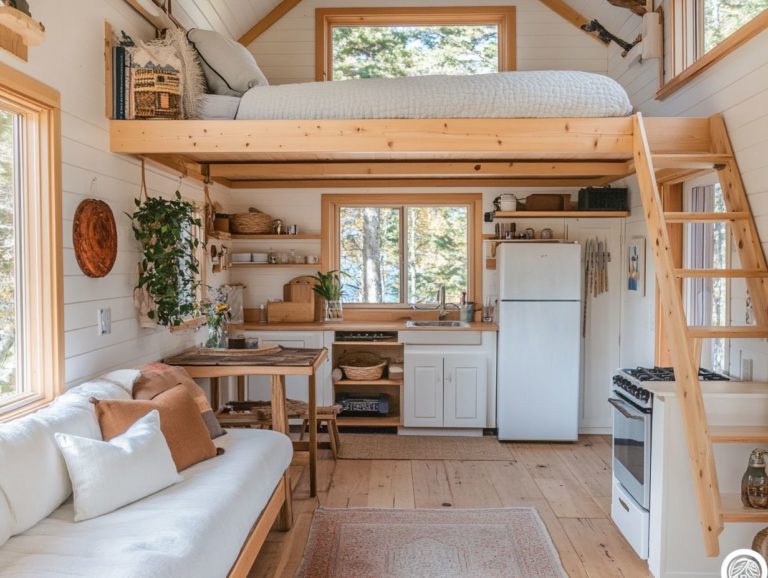DIY Tiny House Solutions for Minimalist Living
Are you dreaming of a simpler, more sustainable lifestyle? Tiny houses offer a perfect blend of functionality and creativity in limited spaces.
This guide provides practical insights for designing your ideal tiny house. Learn how to choose the right location, optimize floor plans, and maximize natural light.
Whether you re considering DIY renovations or embracing a minimalist lifestyle, you can create a cozy, stylish haven that meets your needs while reducing your environmental footprint.
Explore the possibilities and discover how to make tiny living work for you!
Contents
- Key Takeaways:
- 1. Choosing the Right Location
- 2. Designing a Functional Floor Plan
- 3. Utilizing Vertical Space
- 4. Incorporating Multi-Functional Furniture
- 5. Maximizing Natural Light
- 6. Installing Energy-Efficient Features
- 7. Using Creative Storage Solutions
- 8. Incorporating Sustainable Materials
- 9. DIY Renovations and Upcycling
- 10. Creating an Outdoor Living Space
- 11. Implementing Smart Home Technology
- 12. Incorporating Minimalist Design Principles
- 13. Planning for Off-Grid Living
- 14. Budgeting and Cost-Saving Tips
- 15. Maintaining a Minimalist Lifestyle in a Tiny House
- Frequently Asked Questions
- 1. What is DIY Tiny House Solutions for Minimalist Living?
- 2. How can I start living a minimalist lifestyle in a tiny house?
- 3. Are there any benefits to living in a DIY tiny house?
- 4. What are some DIY solutions for maximizing space in a tiny house?
- 5. Can I build a DIY tiny house even if I have little to no construction experience?
- 6. Is DIY Tiny House Solutions for Minimalist Living suitable for everyone?
Key Takeaways:
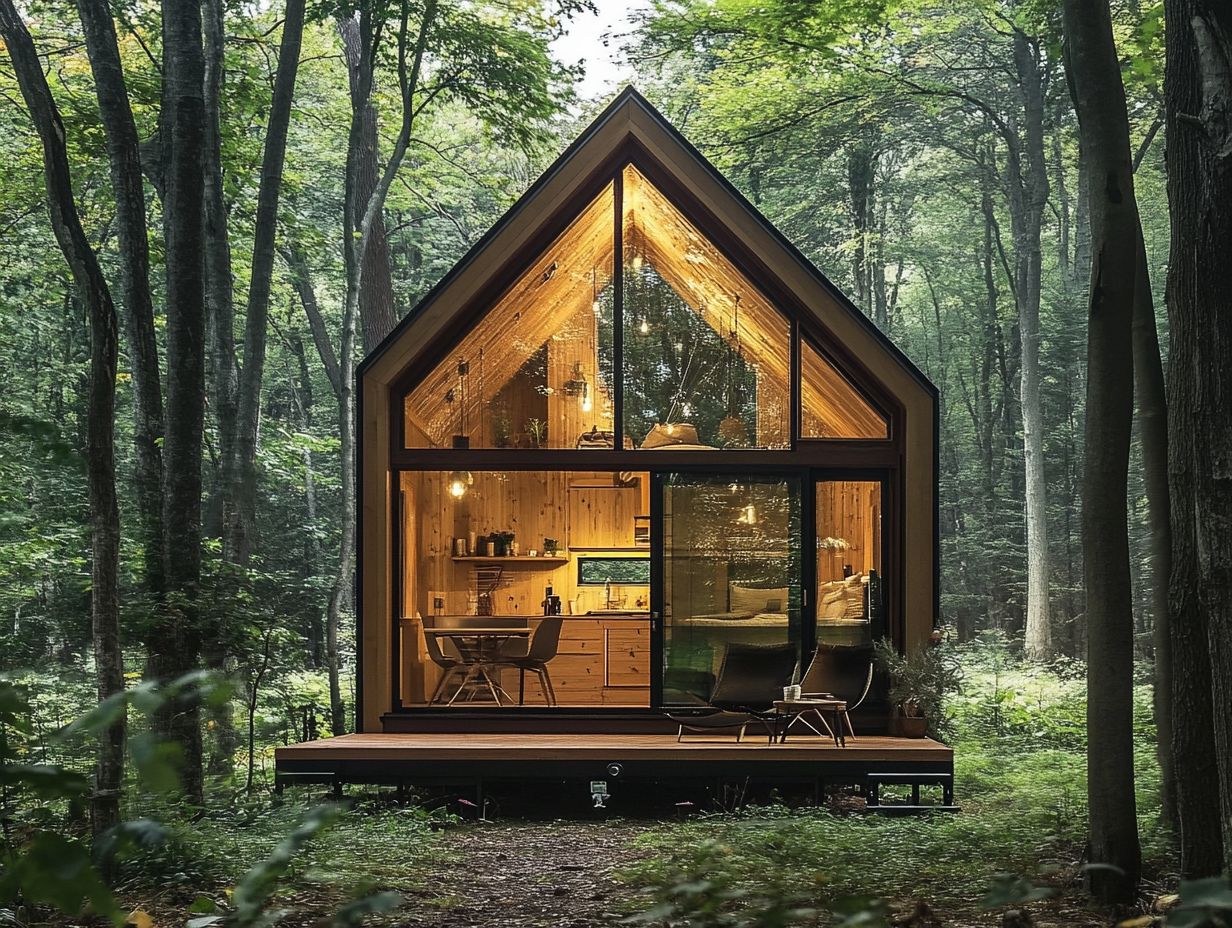
1. Choosing the Right Location
Finding the right spot for your tiny home is crucial. It will shape your lifestyle, community connections, and overall comfort in your cozy space.
Consider whether you prefer an urban or rural setting. Urban areas provide easy access to shops and public transport, while rural areas offer peace and natural beauty.
Look at community features like parks and social hubs. These will enhance your interactions and sense of belonging.
Understand local building rules, as they dictate where you can place your tiny home and any modifications you can make.
Selecting a location that reflects your values can elevate the serenity that tiny living aims for, enriching your experience.
2. Designing a Functional Floor Plan
A functional floor plan is key to maximizing space while creating a stylish, comfortable atmosphere. It should reflect your personal style.
Consider an open floor plan that promotes flow and allows natural light to brighten your home. Innovative storage solutions like built-in shelves will help keep things tidy and accessible.
Use multifunctional furniture, such as a sofa bed or a dining table that works as a desk. For example, combine your living and dining areas with a kitchenette tucked into an alcove.
3. Utilizing Vertical Space
Using vertical space can enhance your tiny home experience. It helps you create clutter-free areas while boosting functionality.
Innovative shelving can free up floor space, letting you display personal items while staying organized. Wall-mounted storage keeps essentials within reach without sacrificing style.
Lofted sleeping areas offer a cozy retreat from daily life. These storage solutions not only improve comfort but also allow you to adjust your living space as your needs change.
4. Incorporating Multi-Functional Furniture
Multifunctional furniture is essential for your tiny home. It optimizes space and ensures that each piece serves multiple purposes.
Choose convertible sofas that easily switch from cozy seating to a comfy bed! This way, you maximize your space without losing comfort.
Drop-leaf tables are a smart option. They provide a compact dining space and expand effortlessly when you entertain.
Stair drawers cleverly exploit vertical space. They provide hidden storage solutions to keep your home organized and clutter-free.
These designs support a simple living lifestyle, allowing you to focus on what matters while creating a serene atmosphere.
5. Maximizing Natural Light
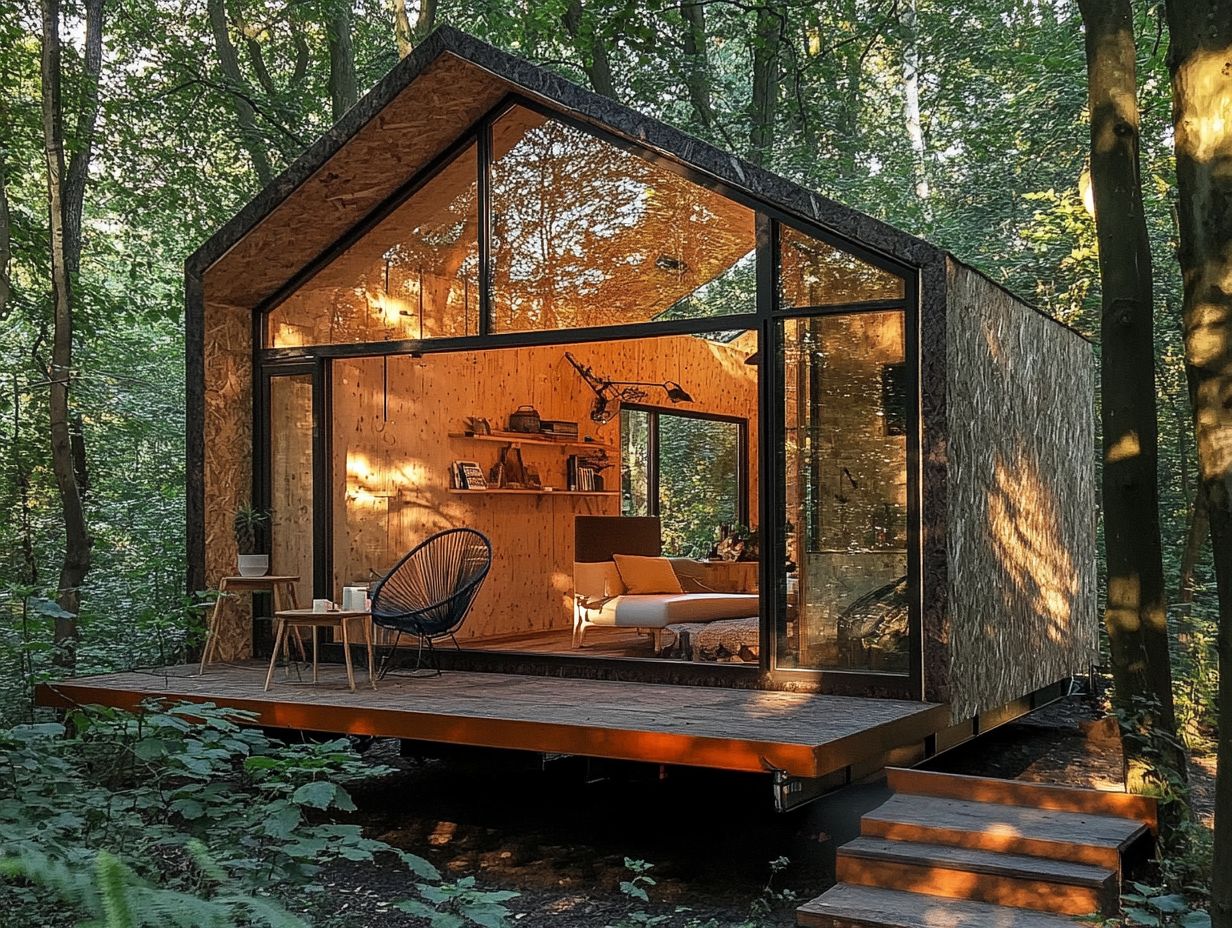
Maximizing natural light is vital for creating a beautiful and inviting atmosphere in your tiny home.
Integrate expansive glass walls that blend indoor and outdoor spaces. This invites warmth and brightness into every corner.
Strategic window placement lets sunlight brighten every corner, fostering an uplifting ambiance.
Use light-colored materials like soft whites and pale grays. They reflect light and create an airy feel, enhancing your cozy micro-living experience.
6. Installing Energy-Efficient Features
Transform your tiny home with energy-efficient features! This not only promotes sustainable living but also dramatically cuts down your environmental impact.
Incorporate solar panels to harness the sun’s energy for your home. Efficient insulation keeps your space warm in winter and cool in summer.
Energy-saving appliances minimize energy use, further enhancing your cozy environment.
These eco-friendly materials create an inviting atmosphere while supporting a greener lifestyle, allowing you to enjoy your space sustainably.
Ultimately, crafting a snug, eco-conscious haven showcases your commitment to personal well-being and the planet’s health.
7. Using Creative Storage Solutions
Employing creative storage solutions is crucial for maintaining a clutter-free environment in your tiny home.
Integrate hidden drawers into your furniture to maximize utility without sacrificing style. You can cleverly conceal items like blankets or books.
Utilize under-bed storage to make the most of wasted space. Seasonal clothing or extra linens can be neatly tucked away and out of sight.
Vertical shelving systems draw the eye upward, creating the illusion of higher ceilings. They also provide opportunities for displaying cherished items.
These innovative strategies help you declutter while encouraging a more intentional approach to what you keep.
8. Incorporating Sustainable Materials
Incorporating sustainable materials elevates your tiny home design and showcases your commitment to eco-friendly living.
Opt for reclaimed wood to infuse character and history into your space. Bamboo is a strong, elegant renewable resource that works beautifully.
Adding recycled steel enhances durability and introduces a striking visual contrast to your design.
Many tiny homes exemplify the blend of style and sustainability. Picture a cozy retreat adorned with reclaimed barn wood or a modern marvel featuring bamboo flooring and recycled steel beams.
9. DIY Renovations and Upcycling
Embrace DIY renovations and upcycling to express your personality and boost your creative skills.
Imagine turning an old wooden dining table into a charming coffee table. A fresh coat of paint and stylish legs can add character and spark conversations when guests arrive.
Try repurposing crates as bookshelves or storage units. They can bring a rustic touch to your decor.
These efforts not only enhance your home’s appeal but also create a cozy atmosphere that reflects your style.
10. Creating an Outdoor Living Space
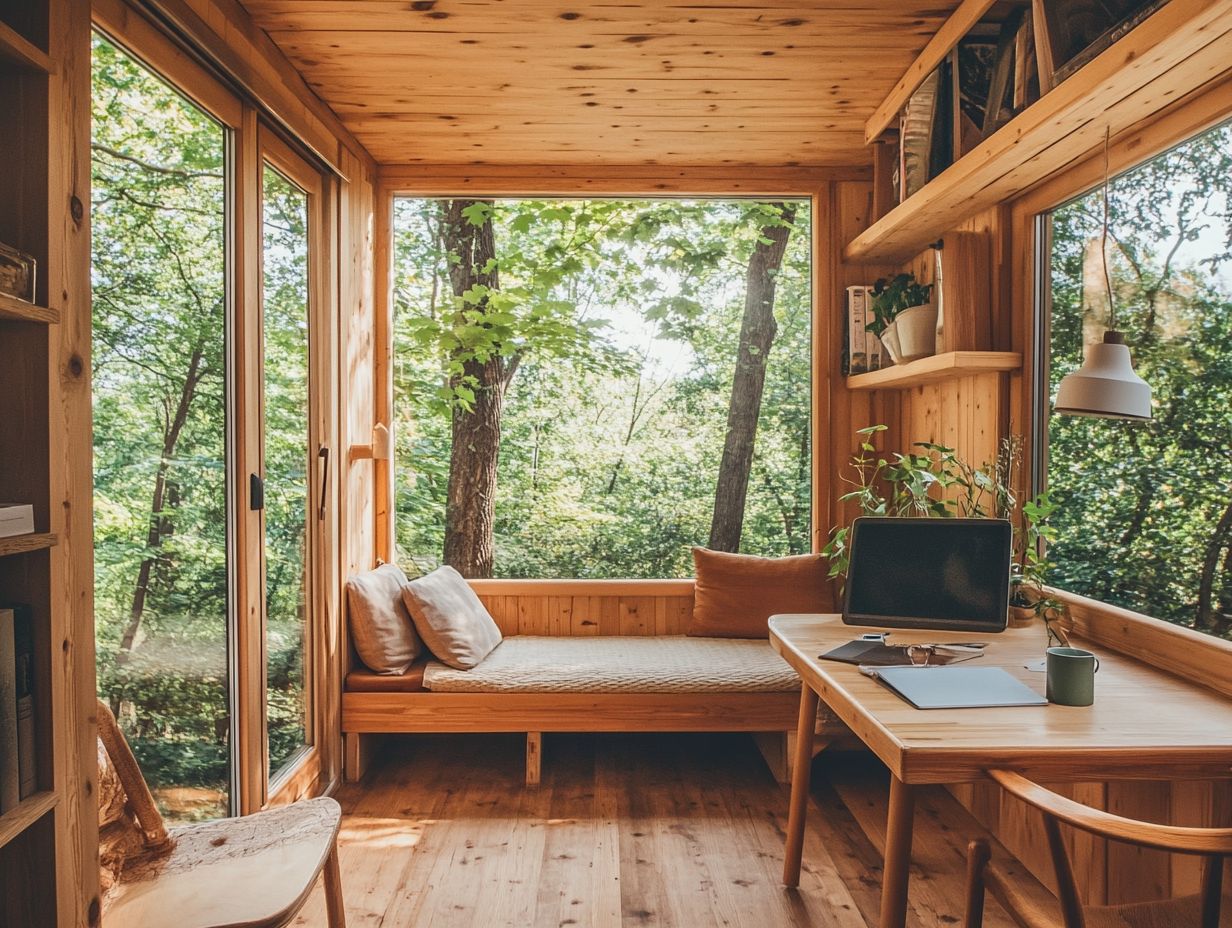
Creating an outdoor living space enhances your tiny home’s cozy experience. It provides a perfect atmosphere for relaxation and socializing.
Incorporate design elements like pergolas, ambient lighting, and comfortable seating. This creates a seamless transition from indoors to outdoors.
Choose furnishings that complement your indoor decor. This transforms your outdoor space into an ideal spot for entertaining or enjoying a quiet evening alone.
Add gardens with native plants or vertical gardens to beautify your surroundings. This fosters a connection with nature.
11. Implementing Smart Home Technology
Smart home technology can improve your living experience. Devices can help automate tasks and increase efficiency.
For instance, smart thermostats learn your heating preferences, conserving energy while keeping you comfortable.
Intuitive lighting systems adapt throughout the day, balancing ambiance with minimal clutter.
Security features like smart cameras and door locks provide peace of mind. Monitor your home from anywhere for extra safety.
12. Incorporating Minimalist Design Principles
Minimalist design emphasizes simplicity and functionality. It creates a clutter-free space that reflects your personal style.
Using a neutral color palette cultivates a calm atmosphere. Natural light beautifully illuminates your open spaces.
Choose decor that speaks to you and essential furnishings. Each element serves a purpose, promoting relaxation and mindfulness.
This approach aligns with modern living, transforming your cozy abode into a tranquil retreat.
13. Planning for Off-Grid Living
Planning for off-grid living in your tiny home opens up a realm of sustainable living options. It encourages you to explore innovative solutions that foster self-sufficiency and environmental stewardship, making it ideal for the tiny house movement.
Dive into this lifestyle! You can tap into renewable energy sources, which are energy that comes from natural resources that are constantly replenished, like sunlight and wind. By using solar panels and wind turbines, you significantly reduce your reliance on conventional utility services.
Water collection systems, such as rainwater harvesting, not only supply essential resources but also minimize your environmental impact, showcasing efficient use of space.
Adopting efficient waste management practices, including composting and recycling, ensures that you produce minimal waste. This is a critical aspect of maintaining a sustainable home and embodying the eco-friendly approach.
The advantages of this eco-friendly approach go beyond mere personal satisfaction. It cultivates a deeper connection with nature and inspires community engagement. This makes the transition to off-grid living an enticing choice for many, reflecting the essence of the tiny house movement, especially when incorporating sustainable design practices for tiny houses.
14. Budgeting and Cost-Saving Tips
Effective budgeting and savvy cost-saving strategies are essential for anyone embarking on the journey of tiny home living. This is especially true when considering creative space-saving solutions. They empower you to achieve your goals without sacrificing the essence of your minimalist lifestyle.
It’s important to prioritize your expenditures by clearly distinguishing between your needs and wants. This approach allows you to concentrate on what truly enhances the quality of your space, often seen in stylish tiny homes.
Choosing eco-friendly materials not only reduces your environmental footprint but also results in long-term savings on energy costs.
Embracing DIY projects can transform your new space into a personalized haven while keeping labor expenses to a minimum. By opting for a tiny home, like the Glass Pod Tiny House or converted school buses, you’ll likely enjoy lower utility bills and reduced maintenance costs. This lifestyle is not just a choice for minimalism but also a financially prudent decision. To maximize your space effectively, consider these innovative storage solutions for tiny houses.
15. Maintaining a Minimalist Lifestyle in a Tiny House
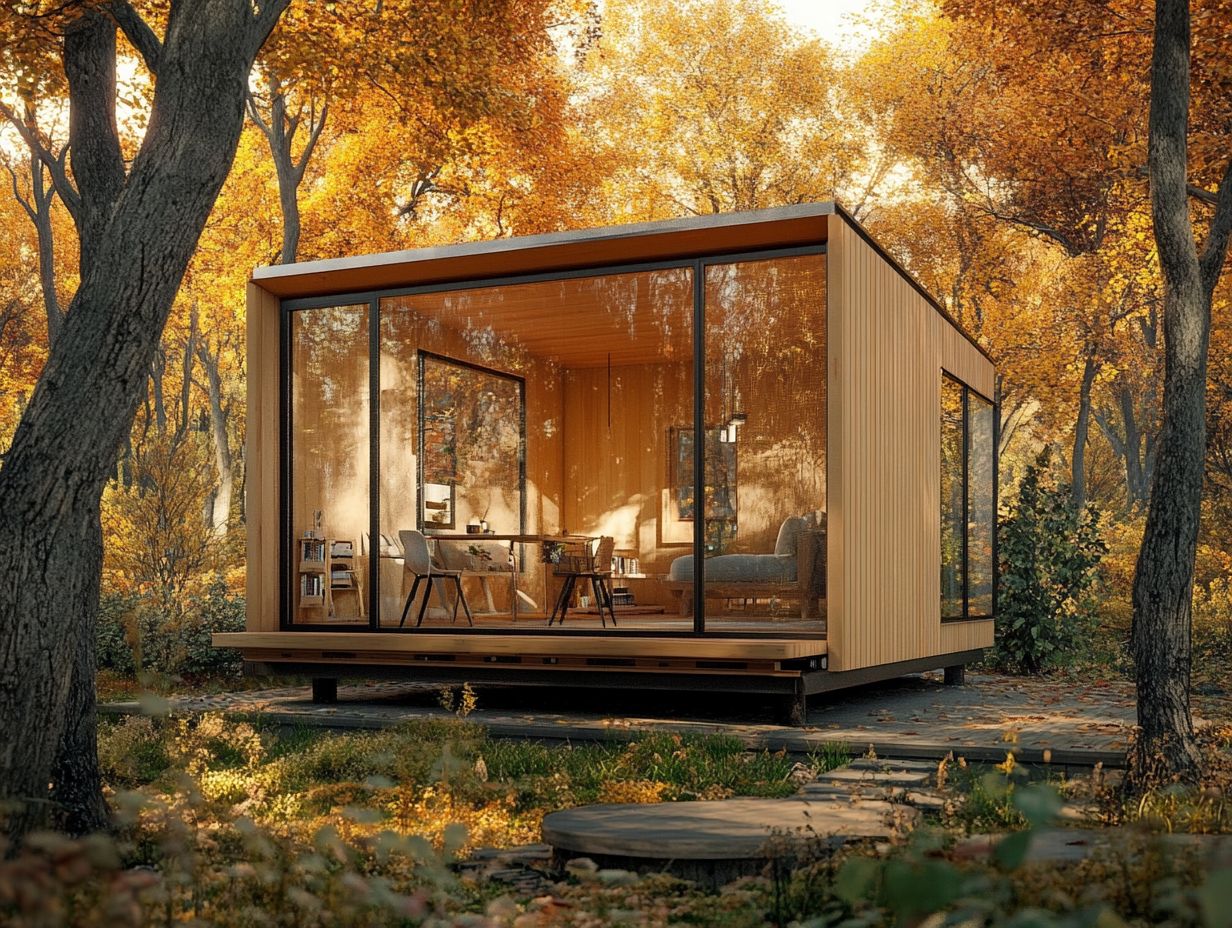
Maintaining a minimalist lifestyle in a tiny house is both a rewarding and challenging journey. It demands your ongoing commitment to keeping your living space organized and clutter-free a principle at the heart of the tiny house movement.
To achieve this, you ll find yourself regularly decluttering. This means reassessing your possessions to identify what truly adds value to your life. Intentional purchasing is another essential strategy; it encourages you to think carefully before acquiring new items. This ensures they align with your values and needs, supporting the principles of efficient use of space.
Embracing flexible living concepts, like multifunctional furniture such as a Drop-leaf table and adaptable spaces, can significantly enhance both comfort and functionality.
Together, these practices create a deeper sense of personal satisfaction, cultivating an environment that reflects your priorities and nurtures your emotional well-being.
Frequently Asked Questions
1. What is DIY Tiny House Solutions for Minimalist Living?
DIY Tiny House Solutions for Minimalist Living is a lifestyle approach that focuses on simplicity, efficiency, and sustainability. It appeals to homeowners interested in the tiny house movement. This approach involves building and designing a small, functional living space using DIY techniques to minimize costs and environmental impact.
2. How can I start living a minimalist lifestyle in a tiny house?
The first step is to declutter and remove unnecessary possessions. Next, start designing and building your tiny house using cost-effective and sustainable materials, often found in stylish tiny homes. Incorporate minimalist principles into your everyday life, such as reducing waste and practicing mindfulness.
What steps will you take to start your off-grid journey?
3. Are there any benefits to living in a DIY tiny house?
Yes, there are many benefits to living in a DIY tiny house. Imagine enjoying lower costs and a simpler lifestyle! It can also spark your creativity and self-sufficiency while reducing your environmental impact.
4. What are some DIY solutions for maximizing space in a tiny house?
A DIY tiny house could be your new adventure! There are many creative ways to maximize space, including using furniture that serves more than one purpose, like Stair Drawers.
You can also use vertical space with shelves and storage units while incorporating hidden storage compartments. You can design your tiny house to have an open layout to make the most of the available space, showcasing modern design.
5. Can I build a DIY tiny house even if I have little to no construction experience?
Yes, you can build a DIY tiny house even if you have little to no construction experience. Many resources are available, including online tutorials and workshops that can teach you the necessary skills.
Additionally, you can get guidance from Mojo Boutique and enlist the help of friends or family who have more experience.
6. Is DIY Tiny House Solutions for Minimalist Living suitable for everyone?
While DIY Tiny House Solutions for Minimalist Living can be a great option for many people, it may not be suitable for everyone. It requires a certain level of adaptability and a willingness to let go of material possessions, especially in stylish tiny homes.
It’s important to consider if this lifestyle fits your needs, particularly if you have a large family or specific requirements.

